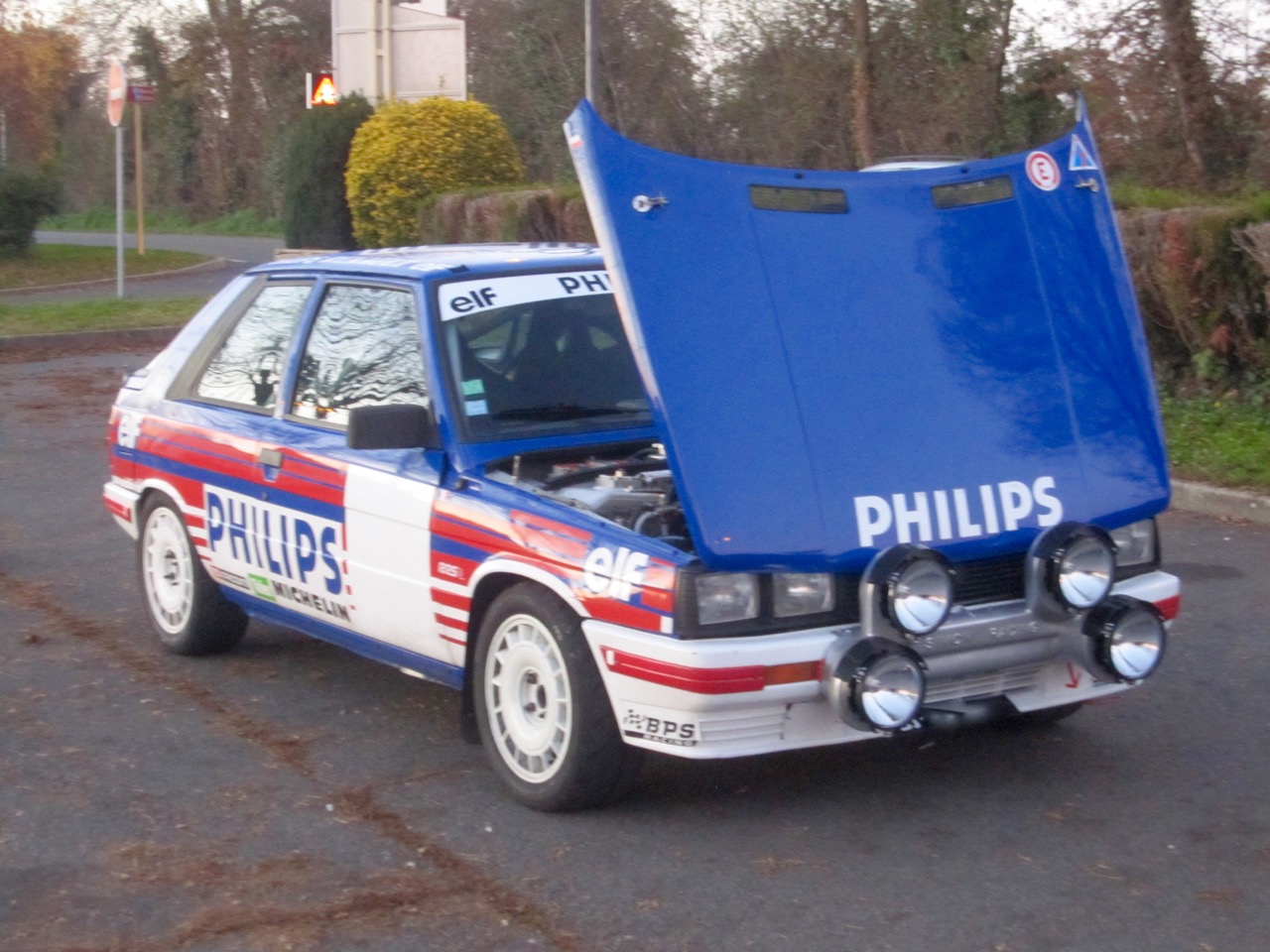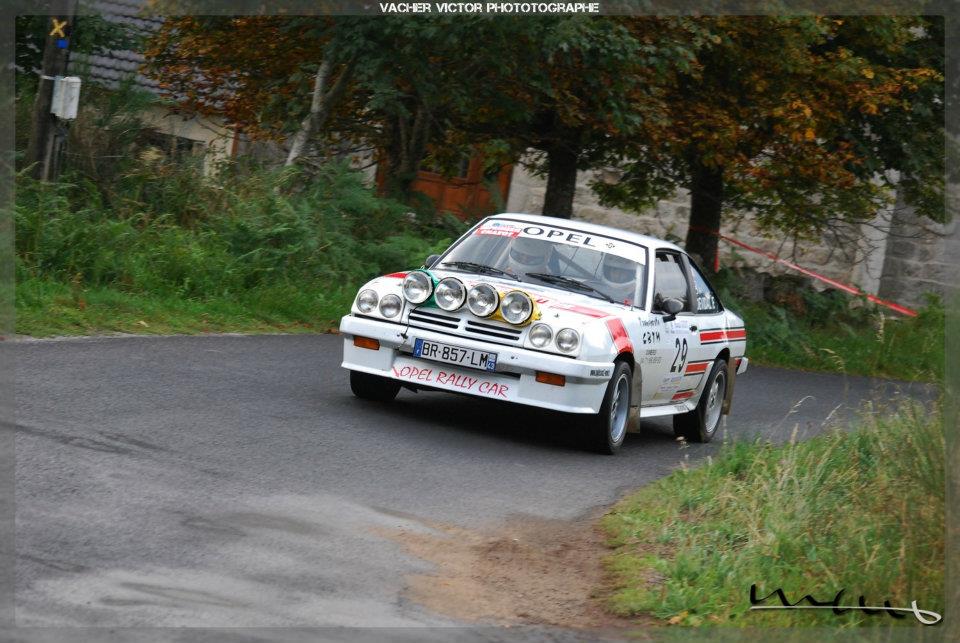We reproduce here a newspaper article with a vintage test of the R11 turbo in version 150 hp gr A
Of course, the introduction is dated 1985, there are concerns that are no longer relevant today, in particular the gr B and the presidency of Jean Marie Balestres at the head of the FIA. On the other hand, the testing of cars, the driving sensations are still relevant today. And even if there are currently much more efficient and above all more powerful. (The powers mentioned in the article can make people smile today). And yet with their weight contained a Renault R11 Turbo grA like the one we have for hire , or an Opel Manta Gsi still manage to rank in the top 10 scratch today if it is well driven and shod.
The photos we produce are they current.

Group A has been in the hot seat for a few months! In the aftermath of the Swedish rally, Balestre, eager to put some sticks in the wheels of the current groups B which he considers too expensive (let’s not prove him wrong), too dangerous, but above all whose success delighted him on the stage international, spoke of a parallel drivers’ championship open only to group A. Today, there is talk of reserving, from 88, a modified group B for the events of the world championship while the various national championships would be contested with group A Far from all these politico-demagogic considerations, it should be recognized, after a timid start, the current success of group A. Taking stock of this material through an essay became a necessity …
Renault 11 Turbo and homologations
Approved since April 1, 1984, the R11 Turbo did not take long to win. First in group N then now in group A. So much so that many people have invested in an R11 Turbo. For those who are always tempted by the adventure, it is advisable to provide some details. Approved in group A and group N, the 11 evolves with the vintage 86. There has just been the release of the Zender approved since this month in group A (500 copies were enough according to the rule of evolution of group A). It will not be in group N on the other hand since it imposes 5,000 copies in one year. The interest of this Zender lies in the axle – 4 bars ”which it borrows from the R5 GT Turbo. It is more efficient. The problem is that this same axle is fitted to all 11 Turbo vintage 86s and therefore these cars are no longer homologated … in group N. To run in group N with an R11 Turbo 86, you would have to go up the ‘old rear axle or else wait for a new homologation (5,000 copies again) which will not take place (at best) before the end of the year or even … invest in an R5 GT Turbo which in group N seems a better choice. This had to be said however |
Note that our turbo R11 is precisely equipped with the famous 4-bar axle mentioned here and which is part of the approvals of 1985.
The comparative test with the other gr A and their production versions: Alfa GTV6, 205 gti, Golf GTi, Opel Manta Gsi
We just wanted to take stock in a slightly more original way, a little less ordinary. Admittedly, this is still a test race and we obviously sought to get behind the wheel of the main group A driving French rallies, but we also endeavored to highlight all the work that their preparation requires to achieve a such degree of competitiveness. This compared to the production model, each of which derives more or less closely. It remained to quantify the technical aspect of these group A through the stopwatch. Measure and gauge with the small needle what the long hours of work and development of racing cars could represent. To do this, we invited their usual pilot to a small timed session. At the wheel of their own racing car of course, but also behind that of an identical model but completely … series. Also, throughout this test have we intimately mixed the racing car with the rigorously standard one. In order to stand out and measure all the possible differences! In our rallies, the benchmark is undoubtedly the trio made up of Yves Loubet, his Alfa GTV 6 and Gema Racing led by Gérard Mandréa who turns out to be much more than the simple preparer of Yves Loubet’s car. For three seasons now, the Alfa has remained the car to beat. In France where we can no longer count Loubet’s successes but also abroad where when the team moves abroad, it leads the (very) hard life to the references of the world championship. Remember a certain San Remo 84 where Yves and his Alfa led the dance in front of the rising star Grundel and his factory Golf. And then there is this last Tour de Corse where the French pilot’s race forced the admiration of observers and … not the least. All this to say that even in group A where the means are obviously not comparable to those developed in group B, the level is set very high. This supremacy of the Alfa, they are several to dispute it. Starting with Alain Oreille, who since this season has been abandoning group N where he had nothing more to prove, for group A with the official entry of a Renault 11 Turbo. This Renault 11 Turbo, developed, of course, by the small Renault Sport team, but carefully prepared by Edmond Simon, the sorcerer of Avignon, is something of the novelty of the year. A novelty which, we will see, despite a development still halfway, was quick to prove itself by winning its first successes with the complicity of the talent of Ear. To do without this novelty would have seriously cut this test. Then comes the small Peugeot 205 GTi that we can qualify as official since it is none other than the GCAP car and driven by Jacques Dubert that we invited to this test. A 205 GTi group A which, like the Yves Alfa that we tested in 1983, is not unknown to us. The presentations took place last year on the dirt track of Cergy Pontoise. The land, a land where the little cousin of the Turbo 16 had conquered the first letters of nobility. The 205 took advantage of the precarious grip conditions and its exceptional road handling to compensate for its lack of power due to its low displacement and to win against much more powerful competition. At the time, Dubert’s car was the only 205 GTi group A (prepared for the GCAP by Bernard Bouhier) in existence. Today, with the catalog of special parts marketed by Peugeot Talbot Sport, nothing could be easier than developing its own 205 group A. By putting the budget there (we will come back to this rather thorny aspect) nothing prevents to have strictly the same car as Dubert. It’s all about the budget, but the formula developed by PTS has the advantage of existing and considerably simplifying the task of pilots and the work of preparers. Guy Chasseuil for his part did not choose an easy solution. In charge of sales in a large Parisian VAG dealership (Gauthier), he opted for a Golf GTi. An interesting choice but a difficult adventure to complete when we know the difficulties in obtaining certain parts and when we know that the factory has so far only developed
cars mainly intended for the land of the world championship events. The car of Kalle Grundel last year (now passed successfully on a 205 Turbo 16 prepared by Oreca) which has accumulated the exploits and places of honor as well as those of Kleint and Wittman this season. Factory cars made rare appearances on asphalt where they never displayed the same ease and level of competitiveness as on gravel. In fact, it was Guy Chasseuil himself who carried out the tuning of his car with the factory engine, however, and with the help of Vincent, his faithful mechanic (for eight years). Unfortunately, we only see too rarely the VW Golf 1 800 by Guy Chasseuil. During the last two editions of the Tour de Corse where unfortunately the tandem was forced each time to retire for small technical problems but also during the last Monte Carlo where Chasseuil failed a few seconds from Balas for the group victory. It seemed interesting to us to talk about the difficulties that a private, unstructured, could encounter in preparing a foreign car. There remains the case of the Opel Manta GSi by Jean Egal. Admittedly, the choice of this Opel group A may seem surprising. Why opt for a “dilapidated” Manta GSi when the factory is developing a Kadett GSi group A which may appear much better armed. First of all because the Kadett is still in the development phase and absent from the French ral | yes (while waiting for Jean-Claude Fabre’s car still virgin of any rally). Then, in this riot of hyper-sophisticated and expensive equipment, the Manta GSi represents a very interesting cost / performance compromise. In addition, it is not devoid of competitiveness since Jean Egal, the Auvergne dealer (Auvergne Auto) leads the group during its outings in the rallies of the 2nd division and the cup on gravel (1st in the Terre de Provence ). Alfa, Renault, Peugeot, VW and Opel here is a range of the brands which animate the group A of each of our national rallies but do not forget that in front of each racing car of this test, there was also a production model so well that it is about ten cars that we found on a small road in the Aix hinterland. A small winding and bumpy road where the imperfections of a racing car are revealed very quickly.
The preparation of a 1985 Group A:
Preparing or developing a group A is not just giving a car a more powerful engine, a transmission adapted to the use to be made of the car, larger brakes from a of their model. Peugeot has understood this perfectly by developing a whole sporting activity around the 205, its top model but also the Régie Renault which is developing in group A the 11 Turbo and the 5 GT Turbo in group N Even importers seem to find their account there. since Loubet, like Balas (also in group A), and Panciatici (in group N) receive substantial assistance from Alfa Romeo France. Like any self-respecting racing car, weight becomes the enemy and in this regard, Group A defines things with precision by a scale according to the displacement. It’s up to the preparer to do with || However, it must be recognized that some bases access the minimum required without too much difficulty while others require titanic work. The Peugeot 205 GTi and the Renault 11 Turbo, front-wheel drive of a fairly simple design, both have no difficulty in flirting with the minimum, namely 800 and 880 kilos respectively. The Alfa requires considerable work. So when we tested the Loubet Alfa two years ago, no less than 140 kilos had been gained compared to the production car. An already considerable gain but which nevertheless left the Alfa at 1,100 kilos while the mini
mum remained fixed at 960 kilos. At the time, the Alfa was prepared at Luigi in Belgium. Since then, the small team has grown and matured, Gérard Mandréaructura by creating Gema Racing responsible for the preparation of the car and its operation. Car which took advantage of it, by a considerable work, to gain still some … seventy kilos. A job that consisted in chasing away the slightest gram by scratching here and there, piercingnt everything that could be drilled (certain parts of the structure or the various supports and fixings) and going so far as to reduce by sanding the thickness of the sheet of the non-load-bearing parts of the hull (roof for example) as well as hoods and readsusual card urs. Dared! Such an Alfa GTV 6 only admits more than 1,030 / 1,040 kilos and it is not clear what solution could allow its weight to be reduced even further. Gema Racing seems to have done everything in its power in this area. In the clan of groups A a little “fat” of this test, let us also notice the Opel Manta of Jean Egal which tops out at 980 kilos and … the VW of Guy Chasseuil who admits never really trying to build a car slight. However, he was far from thinking that his car weighed 945 kilos and promised to activate his lightening well aware that the competitiveness of a racing car also depends on its reduced weight. The Golf shouldn’t have much difficulty flirting with the 880kilos to which it is entitled. A small precision in the case of the R11 Turbo. The German specialist Matter markets, at Renault Sport’s request, a fully prepared, lightened, reinforced, re-welded hull fitted with a splendid aluminum roll bar. All at … 55 OOO. F.t the wings. Scheduled for the Tour de Corse run by day, we saved additional headlights and their power supply or even card readers.
The case of the Opel is a bit special since it involves offering a product that is certainly competitive but also economical. The Manta could undoubtedly gain several tens of kilos but at the cost of expensive labor … unless you fix it yourself.
On the engine plan, the Manta is a little less well endowed than the Ascona still homologated until the end of next season. Mainly because [‘Ascona benefits from a carburettor feed a little more efficient than the injection of the Manta and from a more generous camshaft. Group A indeed prohibits changing the principle of power supply and highlights cars that are well designed initially which is not to displease us. Between the Manta and the Ascona, the gap is around ten horses for a total of 165 horses for Jean Egal’s car. It is not the least powerful since the small Peugeot, modest with its atmospheric 1600, admits only 135 horses at the rather high speed of 7200 rpm for a torque of just under 16 mkg at … 5600 rpm and Alain Oreille’s Renault only 153 horsepower at 5700 rpm for a very interesting torque of over 22 mkg from 4000 rpm thanks to the benefits of its turbocharger. In fact, the current engine of the 11 group A is closer to a group N than to a group A. Bernard Mangé (Sodemo) works ardently on the development of the “big” engine which will confess according to his guardian angel easily 175/180
horses although its modest single-barrel carburetor could therefore constitute its main handicap. So, the weight / power ratio of the 11 Turbo will come close to that (4.50 kg / hp) of the Alfa GTV 6, whose splendid 60 ° V6 takes advantage of its larger displacement: 2.5 liters. With 230 horsepower at 6800 rpm, it is the only one to cross the 200 horsepower threshold easily.
For the mechanics of his car, Guy Chasseuil knocked directly on the factory door. Factory which gave him (against 50 000 F) an official engine of which It is difficult to know the precise characteristics. 168 horses are nevertheless guaranteed by VW Motorsport which gives this 1,800 a very good output of 93 horses per liter (92 for the Alfa, 82.5 for the Opel, 84.4 for the Peugeot and 109.5 but thanks to the turbo, for the Renault which will climb to 130 hp / l in the future). It is not very far from the hierarchy of production cars where, however, it is the Peugeot which leads (66.45 hp / l) ahead of the Alfa (64.20), the VW (62.9) and the Opel (55.6) for atmospheric while the 11 Turbo peaks at more than 75 horsepower per liter. In absolute value, it is between 30 and 50% of additional power which was thus found by the meticulous work of the engine manufacturers. However, the possibilities left by the regulations are slim and the work mainly boils down to tuning and balancing the low engine, fitting special pistons to increase the compression ratio and take advantage of the famous 0.6 mm tolerated. on the bore making it possible to gain a few cubic centimeters on the condition of not crossing a class of displacement. For the high engine, the ducts are worked and polished, the valves see their shape redefined but their diameter unchanged (this is the regulation) while the camshaft is special but retains the lifting of the standard one. The original power system is retained but the setting items can be changed. These are roughly the working bases of the engine manufacturer preparing a group A engine. They are a little generalized and do not very often reflect all the hours spent in the development of these sophisticated mechanics. On the transmission side, specific parts are also flocking. It is easy to invest between 15,000 and 40,000 F in this area. The gear ratios are completely redefined, the axle ratio also while one goes up for more efficiency a self-locking whose percentages vary between 40 (205 GTi) and 75% (Manta GSi). Curiously, the Renault still does without this precious accessory. At Renault Sport, we have not yet decided on our choice. We try all the devices up to the famous Torsen which does not limit the slip of the differential but transfers torque from one wheel to the other. At the start of the school year (probably after the Tour Auto), Oreille will have a locking device at the same time as the big engine and an R11 Turbo Zender which will be homologated in July in group A only. Advantage of the approach: the approval by this fact of the famous “4 bars” axle from the R5 GT Turbo and more efficient than the current rear axle. Obviously, in terms of suspension, all these group A use the principles of production cars. Group A obliges it! However, they are deeply modified and redefined by specific parts (light alloy triangles for example on the Alfa GTV 6) often providing a different kinematics but above all designs much better suited to the large racing tires used. Very often specific parts but also springs, stabilizer bars and redefined shock absorbers, adjustable body height or even rigid joints are the lot of the group A well prepared. Although in terms of joints a rigid mounting on ball joints is not always unanimous. The Alfa GTV6 or the Peugeot use this kind of joints but on the R11 Turbo, the Opel and the Golf (for the front axle), we preferred semi-rigid joints using Teflon. Curiously, the Golf sports two stabilizer bars (one big and one small) but that is only to compensate for a lack of “spring” Chasseuil having not been able to obtain what he wanted until now. Examination of the static settings shows that these group A differ significantly from the production models if only by the camber values used. Another area where the difference is significant: braking. You need what it takes in this area! And we do not deprive ourselves of it through the approvals which make it possible to transfigure the series systems. Front discs can become ventilated if they are not standard or seriously increase in diameter and thickness. At the rear, the drums can become discs. The calipers used most often feature four pistons and for even more efficiency, the pilot can often modify the distribution of the braking between the two axles at will from the dashboard or even act on the rear axle only by means of ‘an adjustable regulator. At the two extremes we find on one side the Alfa and the Peugeot, the latter benefiting from parts largely sized for a car of 800 kilos and on the other the Opel which for example retains the original rear drums and ” small »ventilated discs. A choice which may seem modest and which, as we shall see, proves inefficient but a choice dictated perhaps by a concern for economy because other parts are approved and in particular larger front discs – and rear discs in replacement of drums. Also on the R11, the choice is not final. At the time of our test, the 11 Turbo did sport rear discs but the small discs of the 5 GT Turbo. At the front, there are well ventilated discs but those not very generous of a 25 V6. All with standard single-piston calipers. All this will obviously change in the future since the discs and calipers of the Maxi 5 have just been approved. Finally, this review of details will end with the solutions used for the directorates. Obviously, they all have a reduced gearbox. Even the Alfa, now whose production steering too much geared down, remained one of the shortcomings of the first car tested in 1983. But we are curious about the Golf de Chasseuil which retains its standard assistance (optional). This is not necessarily a bad solution because the Golf is a powerful traction group A (170 hp) and also has a serious limited slip differential (50%). Now, we know that if the latter very appreciably improves the efficiency of traction, it also complicates its driving by causing significant steering reactions. Assistance therefore becomes a way of overcoming these reactions. A rough assistance considering that its hydraulic circuit needs a small radiator to function properly. For the dimensions of the wheels, the choices differ. Not in width where it is the regulations which dictate the choice (8 inches in 1600, 9 in 2 liters and 10 up to 3 liters of displacement) but in diameter where the concept of reduction intervenes. In theory, the best efficiency will be obtained through large diameters but the car must not lose too much mobility and above all, I must deal with approved axle ratios in order to avoid pulling too long. So the Opel and Peugeot, for example, originally shod in 14 inches, come down to 13 inches in group A.
The Renault remains in 14 inches, the Alfa in 15 while the Golf de Chasseuil goes from 14 to 15 inches. All this for rim widths ranging from 7 to 8 inches and maximum speeds which are established, due to the new gear ratios, between 140 km / h for the Peugeot (it’s very short) and 190 for the Golf ( it is too long); the average being around 165 km / h. Obviously, such work, such preparation requiring many hours of labor and especially special parts requires a … nice budget. We have sought to quantify the cost of the cars in this test. It is sometimes easy, sometimes difficult but always quite confusing … in front of the advanced sums. Making the same car that Yves Loubet requires about a budget of 400,000 F just for the car. The three front pull-ups between 220,000 and 250,000 F. It is not within the reach of the first purse! We are obviously talking about a top level car where everything that had to be done to make the car competitive has been done. In fact the most reasonable budget concerns the Opel Manta. It is undoubtedly not the most efficient of the group A but it offers an unbeatable price / performance ratio. Starting from a new car and opting for the big brakes which were not fitted to Jean Egal’s car, we barely reach 165,000 F. Interesting 1 But above all what is interesting with the Opel of an age already “ripe”, it is its second-hand market. It would even be ridiculous to start with a new car since by playing well with the occasions one can manage to make a Manta group A for barely more than 100,000F. Moreover, in general, if the official or very well structured teams start from a new base for better performances, the independent or the amateur has every interest from an occasion or even from a damaged car that we will rebuild with a bare hull carefully welded and reinforced. The final cost is seriously reduced for a performance gap that remains to be quantified …
Make way for sport.
To the south … nothing new! A uniformly blue sky consistent with the idea we have of Provence, a mild temperature welcomes us. The ideal conditions for such a test! The place ? Charleval or rather the D67 which accesses it through the Sèze Chaîne plateau. A small winding and bumpy road, traced on the hillside, which has become famous and … well frequented by rally cars. First of all, it is one of the stages of the Durance round but above all, it is on this same small road that Michelin comes to test its last rally tires and especially that Peugeot or even Audi and Opel come. develop and develop their group B. Why? Because its layout is significant, because all these teams wear Michelin shoes and everyone now has their own brands and references. It was Jean-Pierre Nicolas who was the first to use this small road to develop his racing cars.
As stated previously, we subjected each of these cars to a timed test on this road linking Charleval to Lambesc. The racing cars but also those of series with behind the wheel the respective pilots of the group A. The difference that may exist between a production model and its racing version. Each of the drivers has played the game completely but if we refuse to establish a true hierarchy between the racing cars, it is quite simply because some of them know the road rigorously by heart while others discovered it for the sake of it. the first time. Jacques Dubert, the Peugeot driver (and for good reason) knows every meter of this road. In the same way Alain Oreille for having made the round of the Durance many times, Yves Loubet, Jean Egal and Guy Chasseuil for their part had to learn it quickly, which can explain certain performances. On the other hand, what is much more significant, given that carried out by the same driver, are the performances achieved by each pair of cars, the difference per kilometer that exists between the production car and group A and which reflects the entire work performed and level of readiness. Good dry weather, no problem with the choice of tires. Everyone will be on the same footing. Slicks are essential!
Eager to go in increasing order of power, it is Jacques Dubert’s small 205 GTi that welcomes me. Small car with a small 1600 atmospheric 135 horsepower but also a small weight of 800 kilos. The preparation of the GCAP car is really superb. The Peugeot seems to us all the better made since it is brand new and shines with all its brilliance. Still virgin of any competition, it only covered a few tens of kilometers before it was delivered to us. Immaculate white, the atmosphere is racing. Completely bare interior, free of groundsheets, of any soundproofing. This general stripping does not exclude a good finish which results in well thought out details and accessories. Curiously, the instrumentation remains that of series. Complete, it is true, but perhaps not as precise as one would like. As for example the tachometer graduated up to 8000 rpm, precisely the maximum speed allocated to us by Jacques Dubert and Pierre Toujan. Right, right Well wedged in the deep Sparco “kevlar” (3.6 kg all wet …) the door fittings and the sad steering wheel remind us that we are at the wheel of a 205 GTi. Neiman point, the contact is made by the circuit breaker and start-up by a simple push button. All of our group A start this way. Neiman’s absence eliminating a possible source of boredom. The sound is serious, full. Still, there are only 135 horsepower. But with its low weight and a very short gear ratio, you never feel a lack of power. The gearbox is perfectly staged, the control fast and hyper precise, but you quickly find yourself in fifth gear. It’s short, very short. Peugeot thus tries to compensate for the lack of power of the 205 against the competition. After each curve, the gear is brought up to speed very quickly, almost immediately. This does not go without posing some reliability problems, the transmission being very stressed by this high gear ratio. This is the current Peugeot problem and while waiting to remedy the problem by launching the manufacture of more reinforced parts, the GCAP has decided to mount a slightly longer torque and a lower locking mechanism in order to save the transmission. The power hardly impresses. It happens very gradually, almost continuously. Although light and very lively, this mechanic is very easy to use. As the box is pleasant to handle, there is no shortage of praise for this little Peugeot. Despite the self-locking, the steering reactions are limited, the traction absolutely total. Whether by its traction or by its very balanced behavior, the Peugeot shines by its efficiency. A toy of great ease and rare homogeneity. Stable in fast places, barely understeering, just right, and agile, due to its low weight, in the middle sections. A car that is driven with incredible precision. As for the braking, it also left us with a great impression of efficiency with a very easy dosage, perfect balance and ample power. Admittedly, this Peugeot lacks power, but once again, it is its great consistency that surprised us. Power, we find more abundantly with Alain Oreille’s R11 Turbo. A power coming from a somewhat curious mechanics it must be admitted. The 11 Turbo’s current “small” Group A engine barely revs up. Barely 6400 rpm! Descendant of the 205, this surprises. It does not take a turn but we are immediately at the breaker. This engine is not powerful, it is just crammed with torque. A huge torque from 2000 to 6400 rpm. We go up gears very quickly as the thrust is vigorous at each gear change. He never runs out of steam! According to “Nanard” (Bernard Mangé), the large engine will retain this great flexibility, this vigor but will give more generous power at high revs. There, it is true, one remains a little on its hunger. Fortunately the box is well staged and its handling is as perfect as on the Peugeot. The Renault also sports a very nice preparation finish. The Matter hull for example is a marvel and the general assembly very neat. With its very vigorous engine, the 11 gives the impression of great speed. Especially since in terms of behavior the rest follows. The front axle adheres strongly, the direction is precise, well geared and devoid of reaction. Normal, there is no self-locking! Motor skills are affected but only in very tight or bumpy places. Elsewhere, the need does not arise. Curiously, we quickly forget the turbo compressor. Its time is only annoying when decelerating, when braking, because the car continues to push a little when we have already clearly lifted our foot. This is a little surprising, especially since braking is not the main quality of the Renault. With the current small brakes, the decelerations lack a little conviction and above all the effort required on the pedal is too great. This does not give complete confidence and the dosage is not easy to achieve. Day and night for example with the Peugeot braking. There is no doubt that the Ear Car will evolve considerably in this area in the future. When it has received the big brakes fitted with four-piston calipers and adequate pumps. In fact, the R11 Group A is still in the early stages of its development. Unlike the Peugeot for example, it lacks consistency. Its powerful engine, efficient brakes, but also insufficiently developed and too hard suspensions, especially at the rear. It is almost a prototype car whose evolution continues and none of the parameters are fixed yet. The performance that Oreille achieves behind the wheel is even more valuable. The car is already showing itself to be competitive, Simon has managed to make it reliable quickly and in the future this R11 may prove to be extremely formidable. A seed without a doubt | In terms of behavior, the Oreille car appears to be fairly balanced although a little more understeer, for example, than the Peugeot. It is very rigid on its wheels, hardly takes any roll but is a little too hard, especially the rear which does not appreciate the very bumpy road. He jumps like a kid! Oreille, like Simonet Renault Sport, are well aware of the problem and are working to resolve it. Only, in Aquitaine, the current axle will undoubtedly have made its last test. Rather, we are now busy developing the famous “4-bar” axle which already appears to be more efficient. This does not prevent it from being already very competitive, which augurs great potential. The Alfa had better watch out! With the Opel, we feel that we are changing category. With its strangely lowered rear, its attitude somewhat surprises the commoner. This is to load the rear wheels because it is a … propulsion, one of the few propulsions with which we can still compete in competition. What do you want, fashion is pulling. We now put efficiency before pleasure! We change category because everything seems extremely simple on this Opel. Its design, its mechanics, its preparation. Its mechanics to begin with, all in cast iron, seem unbreakable. Reliability, it is true, is one of the strengths of the Opel. Its slightly metallic sound surprises but above all, this engine shows a good character. The power is good. It revs up well and is well supported in its task by a well-adapted transmission. It is neither more nor less than the box of the Manta 400 that we find homologated on the GSi. Initially, it had the disadvantage of being expensive (36,000 F) but at Irmscher (which develops competition parts for Opels), we sell off seriously (17,600F for the complete box). The control of this box is precise but it lacks a little speed. Oddly enough, when the car is expected to sit up when starting, it rears up on its rear wheels. The traction is good, thanks it is true to a self-locking which amounts to 75%. Paradoxically, while the attitude of the car unloads the front wheels for the rear wheels, the driving remains heavy.
The Manta is a car that must be driven firmly. The steering is well geared but it does not manage to compensate for the lack of incisiveness of a front axle whose efficiency is a little lacking. If you do not force the Manta into the curves, it will understeer what is not the most pleasant. Driven with a little more firmness, its behavior becomes deliciously balanced; the car accepting to slide all four wheels or even more frankly from the rear with the front wheels slightly counter-steered. The traction is not bad despite a rear axle (rigid) which tends to jump a little on bad surfaces. But the big black point remains the braking which lacks too much conviction. The effort required is abnormally high. You pull with all your strength on a steering wheel to finally obtain very arbitrary decelerations. Such braking prevents precise dosing. Be careful, it should not be deduced that a Manta group A does not brake. It’s actually a matter of choice … and price. The parts exist, they can be obtained easily, but they cost more than the assembly fitted to Jean Egal’s car. At the expense of the friendly dealer and preparer from Clermont, he now intends his car for the rallies of the Coupe de France on land where he brilliantly won the group A of the Terre de Provence. On such terrain, the braking criteria are no longer the same as on asphalt with demanding tires. Despite this, the Manta gets away with honors. Even if, as we expected, it was not as swift as the most modern traction systems and the formidable Loubet Alfa, its performance remains very honorable given the investment required. It is certainly not the car for the group in a French championship rally, but in second division or national events, it has its say. This is to be taken into consideration when you are an amateur.
With the Golf de Chasseuil, we are back to front-wheel drive. If it weren’t for its fuller, more powerful engine or the closer gearbox or the noisier exhaust, you would hardly experience the feeling of being behind the wheel of a rally group A. Strangely enough, while we expected the contrary, this Golf is absolutely not physical to drive. The management first of all. We do note a few reactions here and there caused by a high percentage locking (50%) for traction, but the assistance quickly makes them forget. It is more direct, more incisive because of this and through the broad racings but there is hardly any effort to be made. “This assistance was quickly imposed as the car was difficult and trying to drive without this equipment”, explains Guy.
Chasseuil. The brakes also, despite specific parts such as large ventilated discs, four-piston calipers or a double master cylinder making the repair adjustable, also retain their assistance system. As much as the direction made our job easier, the brakes handicapped and confused us. It in no way compromises the decelerations of the Golf which remain effective, but on the other hand we experience some difficulties in dosing well … for lack of feeling. The pedal is a little spongy, its stroke a little too long. And above all, when braking hard downhill, we feel, compared to the Peugeot for example, that it continues to push behind. The Golf has a few extra pounds and it shows. 945 kilos is way too high for this small front-wheel drive. Guy Chasseuil himself did not think his car was so heavy. Even if the second Golf has a bulkier and heavier body than the first, it should nevertheless not experience much difficulty in flirting with the minimum: 880 kilos. Guy and Vincent have their work cut out for them in this area. In fact, this Golf is in the process of being tuned. Three rallies in one year even if they are world championship events, it is not enough when there is everything to do. Chasseuil is well aware of the difficulty: “hastily prepared by RAS in Belgium, almost everything had to be started from zero at the start of the first race. We had to develop our own suspensions for asphalt because it was impossible to get parts from the factory. Even after three rallies, they are still imperfect. The two stabilizer bars, for example, are only there to compensate for an insufficiency of the rear springs. It is true that the German car was not quite at ease on this very specific bumpy terrain requiring efficient suspensions. Too flexible, especially at the rear, it tended to roll too sharply which ended up deteriorating traction despite the high percentage locking. As a result, it lacks a bit of mobility and agility. Its weight is felt in acceleration especially as, although ideally staged the reports appeared too long to us overall. 80 in first, 109 in second, 137 in third, 166 in fourth and … 190 in fifth. It’s more of a circuit box than a rally drivetrain. The car would gain enormously by fitting a shorter bridge. We can sense a great potential but which remains imperfectly exploited for lack of development. There is no doubt that Chasseuil and Vincent will achieve this quickly by dint of trying! The Loubet Alfa is the size up! A bulkier car, more imposing and then … this engine. This magnificent V6 which in its group A version provides unparalleled pleasure with horses everywhere, at all speeds. 230 horsepower is the power of the Alfa V6 in Group A now. He has not stopped improving for two years since during our first test, he admitted only a small 220 horsepower. And even… At this timeIt was Luigi, the Belgian preparer who had ensured his transformation. Subsequently, Loubet used a factory Autodelta engine but now it is Gema Racing which takes care of the preparation of its engines with the rest of the car. A preparation which once again commands the admiration of observers. Each part, each detail has been reconsidered, within the limits of the regulations, to provide the maximum efficiency but also to track down the slightest superfluous kilo. A superb work that Loubet knows how to exploit to perfection. This famous V6, which will remain among the most beautiful engines produced, appeared to us to be more powerful than when we first met, but above all more frank, even more vigorous and remains even easier to use. It has progressed enormously and provides a most pleasant roundness. The transmission is short this time, much shorter than on the Golf de Chasseuil. Barely more than 165 in peak. That’s what it takes in rallying. The reports follow one another quickly. We hang the fifth after a few hundred meters.
On the other hand, the pinions with right size (for less friction and a faster selection) are always so noisy. The box noises manage to cover the beautiful sound of the engine and in the case of a V6, it borders on sacrilege … The shifter travels are reduced more than before but the clutch control is still slow. On this level, we find the temperament of the Alfa. Yet that hardly seems to bother Loubet. You have to see him manipulate this transmission with incredible precision and speed. The engine is not the only organ to have made significant progress over the past two seasons. Would it be the same car? We don’t know if this is thanks to the enormous weight savings achieved or the careful work and tuning of the chassis, but Yves’ car appeared to us to be much more agile than it was two years ago. Sharper, more agile, more incisive in its reactions and more precise to pilot. The direct management approved since plays a large part in this finding. The gestures are more measured, the placement of the car infinitely more precise. By dint of hard work, the team has almost managed to erase the laziness, the initial inertia of the Alfa front axle. This is important because this lazy side of the front wheel handicap
have GTV 6. A better front axle, an even more powerful and above all more flexible engine, a considerably reduced weight, the Alfa group A has evolved considerably. Despite the important work done, it remains a bit heavy. 1,040 kilos in Group A is among the high values. It is especially felt when braking. It grows ! The pedal stroke is a bit long for my taste but the decelerations are energetic. And then there’s always this lack of front suspension travel. It often happens, when the coating is bad or dented, that the armor (a very beautiful piece of Kevlar and aluminum admitting barely more than 3 kg) comes violently hitting the ground. Impressive 1 Despite this remark, the Alfa still remains the benchmark of the group. By its powerful engine easily usable, by its very efficient, balanced behavior and especially the homogeneity of the setcorn. In this regard, only the Peugeot seemed to us to provide, to a lesser extent due to the lower power, the same qualities.
The Alfa still queen of its category! For how much longer ? She has to worry about. Even in the near future, when the R11 Turbo will have received its big engine, big brakes, self-locking, the cards e careful balance between all the parameters that make up a Race car.
will then be redistributed! Alfa’s salvation may then pass through a Group A version of the new 75. All development achieved
on the GTV 6 will be transposable on the 75 which will have the advantage of a weight fixed this time at the minimum homologation. The future promises us great equipment again!
Opel kadett Gsi gr A
A few months ago, we had tested a Kadett GS1 prepared in group A. At the time of the launch of the new Kadett range, Opel had the good idea to bring its extrapolation intended for competition as well. Since then, the Kadett group A has appeared several times and with some success. In RAC 84 and Rally Sweden 85 in particular. The problem with this Kadett is its total absence in French competitions. Not for long since Jean-Claude Fabre, the Puteaux dealer known for his Corsa kites, has just developed his own GSI group A. It’s a brand new car still untouched by any competition and … to the point, moreover, which has been entrusted to us. Jean Claude Fabre has in some cases taken over the solutions from the factory. In others, they are unique to it. Starting with the engine that he developed from his own parts. For the moment, he gives it for 160 horsepower while relying on a significant flexibility of use. It is true that this engine is quite flexible. It does not resume frankly from 4000 rpm but is not to be considered as a sharp engine. On the other hand, its power is a little limited at high revs. The maximum speed is fixed at 7,500 rpm but the last 500 rpm are difficult to find. Maybe it lacked a little break-in but a new camshaft is still under study. The box, the self-locking, comes from the factory. The whole is very competitive thanks to a gradation of reports and a judicious reduction despite the fifteen-inch wheels which was far from being the case for example with the small Corsa. The only irritating detail in the long run: the gearbox control which lacks too much rigidity and which ends up lacking in precision during rapid handling. We had already criticized the same on the us carine. The second fault concerns the braking and again, the same problem affected the factory car. Besides, the parts are identical. Everything is there for the braking of this car to be effective. Large ventilated discs, four-piston calipers, rear discs, a hydraulic handbrake and up to the double master cylinder to change the distribution between the two axles from the dashboard. The ultimate! However, these brakes lack teeth and above all the pressure to be exerted is insane. To review. Jean-Claude Fabre has developed his own suspensions in view of the impossibility of obtaining those from the factory. At the rear, there are Bilsteins with specific springs while at the front, it transforms standard legs always with specific springs. As a result, the ride height is not adjustable. We may do better elsewhere, but this has the advantage of being a little more economical since the investment required for a Kadett of this type does not reach 200,000 F. Such a choice would have seemed much more judicious to us. than that of the Corsa within an Opel trophy because already as it is and yet lacking in development, it is much more efficient. The grip is great, the behavior fairly well balanced (slight understeer tendencies nevertheless) despite the suspensions still unsuitable. Damping is not ideal and the car is not easy to drive over difficult and bumpy terrain. She bounces from bump to bump and loses her motor skills. Nevertheless, the potential seems very interesting. (Previous test: Exhaust no 192)
Products from our shop related to this article:
-

Baseball Polo with Clio Williams maxi Diac design
€44,00 TTC Select options This product has multiple variants. The options may be chosen on the product page -

Denim polo shirt with a Clio Williams maxi grA Diac design
€44,00 TTC Select options This product has multiple variants. The options may be chosen on the product page -

Alfa Romeo GTV6 Yves Loubet Rallye d’Antibes 1985 pocket print T-shirt
€29,00 TTC Select options This product has multiple variants. The options may be chosen on the product page -

Sweat Alfa Romeo GTV6 evocation Yves Loubet Rallye d’Antibes 1985 cotton hoodie- UNISEX
€125,00 TTC Select options This product has multiple variants. The options may be chosen on the product page -

Polo Alfa Romeo GTV6 evocation Yves Loubet – Rallye D’Antibes 1985
€59,00 TTC Select options This product has multiple variants. The options may be chosen on the product page -

Alfa Romeo GTV6 Yves Loubet Antibes Rally 1985 T-shirt
€35,00 TTC Select options This product has multiple variants. The options may be chosen on the product page -

Clio Williams maxi Gr A Diac t-shirt
€29,00 TTC Select options This product has multiple variants. The options may be chosen on the product page -

GrA Déco Philips R11 turbo rally T-shirt Jean Ragnotti
€35,00 TTC Select options This product has multiple variants. The options may be chosen on the product page -

Polo R11 turbo grA Philips Jean Ragnotti
€59,00 TTC Select options This product has multiple variants. The options may be chosen on the product page -

Renault Maxi 5 Turbo Diac Ceramic Mug
€16,00 TTC Select options This product has multiple variants. The options may be chosen on the product page -

Polo Renault Maxi 5 turbo Diac Man 180g
€59,00 TTC Select options This product has multiple variants. The options may be chosen on the product page -

Renault maxi 5 turbo Diac t-shirt
€36,00 TTC Select options This product has multiple variants. The options may be chosen on the product page
-

Polo Denim Collar BMW M3 E30 grA Thierry Neuville – Spa Rally 2022
€39,00 TTC Select options This product has multiple variants. The options may be chosen on the product page -

Polo Baseball BMW M3 E30 grA Thierry Neuville – Spa Rally 2022
€39,00 TTC Select options This product has multiple variants. The options may be chosen on the product page -

T-shirt BMW M3 E30 grA Thierry Neuville – Spa Rally 2022
€35,00 TTC Select options This product has multiple variants. The options may be chosen on the product page -

Polo Lancia Delta Integrale 16S evo grA VHC Rallyes
€39,00 TTC Select options This product has multiple variants. The options may be chosen on the product page -

Polo Peugeot 309 GTI 16 gr A VHC –
€39,00 TTC Select options This product has multiple variants. The options may be chosen on the product page -

Polo Peugeot 309 GTI 16 gr A VHC
€39,00 TTC Select options This product has multiple variants. The options may be chosen on the product page -

Baseball Polo with Clio Williams maxi Diac design
€44,00 TTC Select options This product has multiple variants. The options may be chosen on the product page -

Alfa Romeo GTV6 Yves Loubet Rallye d’Antibes 1985 pocket print T-shirt
€29,00 TTC Select options This product has multiple variants. The options may be chosen on the product page -

Sweat Alfa Romeo GTV6 evocation Yves Loubet Rallye d’Antibes 1985 cotton hoodie- UNISEX
€125,00 TTC Select options This product has multiple variants. The options may be chosen on the product page -

Polo Alfa Romeo GTV6 evocation Yves Loubet – Rallye D’Antibes 1985
€59,00 TTC Select options This product has multiple variants. The options may be chosen on the product page -

Lancia delta Integrale 16S Evo grA HCV T-shirt
€29,00 TTC Select options This product has multiple variants. The options may be chosen on the product page -

Clio Williams maxi Gr A Diac t-shirt
€29,00 TTC Select options This product has multiple variants. The options may be chosen on the product page

